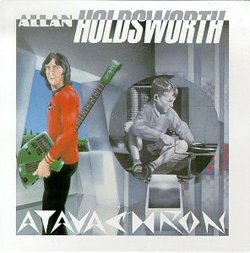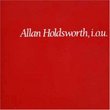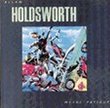| All Artists: Allan Holdsworth Title: Atavachron Members Wishing: 4 Total Copies: 0 Label: Restless Records Release Date: 7/1/1993 Genres: Jazz, Pop, Rock Styles: Jazz Fusion, Progressive, Progressive Rock, Rock Guitarists Number of Discs: 1 SwapaCD Credits: 1 UPC: 018777256124 |
Search - Allan Holdsworth :: Atavachron
 | Allan Holdsworth Atavachron Genres: Jazz, Pop, Rock
|
Larger Image |
CD DetailsSimilar CDs
|
CD ReviewsExtension of Harmony: Holdsworth & Schoenberg John M. Bordeaux | Winterville, GA, USA | 07/06/2007 (5 out of 5 stars) "Allan Holdsworth is known to have learned about scales through a personal application of mathematics. He sought all the possible permutations of tone interval sequences (not just different orders of a given set of notes, which will be discussed later),that is, a given set of spaces between notes. Only working within the 12-note (even-tempered) system of intervals (12 notes to an octave, the thirteenth being a repeat of the first, but an octave higher [double frequency?]), he did this for four, five, six, all the way up to nine-note scales, and filed them all away. He then went back through them and eliminated all the ones that had more than four semitones (half-steps) in a row (was this for reasons of personal taste, or is there a higher purpose? Compare to the fact that he also stopped with 9-note scales. These may have the same root reason: if you limit yourself to no more than four semitones in a row within an octave, 9 is the largest possible number of tones that scale can contain.). What was left to him were interval sequences he applied as musical scales; many of these likely would be recognizable by musicians as familiar scales, or modes of them, and many others would probably sound unfamiliar to a trained musician. Holdsworth himself acknowledges that all the modes of the scale are equal to the scale itself, just using different starting notes. In his process he probably also identified and eliminated scales which were contained within other ones (the modes). I use here as a familiar example the major scale, which contains the Aeolian mode or natural minor scale (beginning on the 6th scalar tone and going up an octave, all within the notes of the major scale), the Mixolydian (beginning on the sixth), Dorian (a minor scale beginning on the second note), etc.; C to C is a major scale, D to D is Dorian, E to E is Phrygian. For these familiar seven note scales, eliminating the modes trims down the number of possible interval combinations by six automatically. Through this process he sifted through all of the combinations and teased from the multitude the essence: unique sets of intervals which comprise true separate scales. This seems a simple and finite, if arduous, application of effort, if one were to limit himself to only the seven note scales; Holdsworth (I believe) started with four-note scales and kept going until most likely absurdity intervened. He avers that he analyzed the scales in an attempt to find the chords within them. The ultimate goal of all the math was to supply himself with resources to improvise over chord sequences such as those found in jazz and popular music. He knew that if he wanted to improvise over chords he had to learn all the scales that went with those chords (how did he know this? His father's influence? Intuition? Also, how did he ascertain which chords and scales "went together"?) Presumably in his analysis Holdsworth found within scales those tones common to chords he already knew (where did he learn chord theory?) and made the connection that C, Dm, Em, F, G7 were all related to the Cmaj scale in that they "contained these chords (all the common tones necessary to sound these chords). Holdsworth also relates his definition of a chord, which is telling: chords are merely notes of a scale played simultaneously. Clinging to his definition for a moment, one can gather a bit more information about his scale/chord concept. In functional harmony there is often a tone sounded simultaneously with others which may not "belong" to that chord or harmony. These usually are explained in harmony texts as incidents of counterpoint (moving voices which may step on each others' toes) or as "passing tones" or notes "borrowed" from another harmony. Certainly in composed music they were not accidents; my thought is that in order to emphasize the order of the whole, one must occasionally allude to the disorder found without. Or could it have been to shock the listener from the comfort of euphony with a small dissonance in order to re-focus attention? Greater minds have already pondered these questions. Under Holdsworth's definition of chords, however, we could be led to conclude that the composer is in fact implying another scale altogether, a scale which may include the diminished fifth or a flatted second in addition to the other scale tones. In this case, if we can flash forward from Mozart's functional harmony to the 20th century's extended harmonies, this definition implies much more complicated chords, or at least the possibility of such. Added tones create dissonances in extended chords. It is here that I would like to make a bit of a leap. As Holdsworth adds notes to his scales (I count notes throughout this work by the number within an octave), we move closer to having the full complement of 12 unique tones in a single system. If we note also that Holdsworth does not think of scales as having beginnings or endings (say, D to D up the octave), then the necessity of having these many tones employed in a particular order over a certain bass note or chord falls away. Further evidence of Holdsworth's liberation from this order is that he does not give the melodic minor scale in his instruction book as sounding one way going up (maj 7) and another going down (minor 7) as is usually presented in classic harmony texts; rather, he merely presents all the notes in every position on his instrument (the guitar) as a continuum of scalar tones. Holdsworth adjures aspiring improvisers to learn the notes of the scale and then "juggle them around" to suit themselves in improvisation (remember the possible number of permutations of 12 notes? It's twelve factorial [12!], which means 479,001,600 combinations, just within a single octave). Further, Holdsworth advises that one has not merely to play combination of C, E, and G over a Cmaj chord, but any combination of notes within that scale such as Dm, Em, G7, etc. as taste dictates. The aforementioned leap is then to relate what Holdsworth is doing, to the profound groundwork laid by Arnold Schoenberg at the beginning of the 20th century. Holdsworth is applying closer-intervalled scales (closer than, say, a seven note scale simply because there are more notes used per octave) over extended-harmony chords (further extended as they are derived from his dense scales), leading to a very systematic and useable set of dissonances. Schoenberg took the entire set of 12 tones, ordered them to suit his harmonic and contrapuntal purposes, and set this order in stone within a given composition. This ordering he called a tone-row: every tone must be sounded, and no tone may be sounded before the one previous to it. Using these forms and their mirror forms (reversing direction of the row), and using the inversion of both forms, he was left with many possibilities. A further limitation of resources (relaxed in later compositions) was that simultaneous soundings of the same note or any of their octaves was disallowed: he felt this would favor one note over another and hence imply a key. The similarities I see are these: both men have given themselves a greater-than-typical number of possible notes to use as scales (Holdsworth max 9, or more if he goes chromatic; Schoenberg 12) over extended harmonies derived from these dense "scales." (It should be noted that Schoenberg's pre-12 tone work was already highly chromatic, so he was already using much of his later pallet within functional harmony.) Both of their compositions result in simultaneous sounding of tones which are difficult to name as chords (Holdsworth's transcribers make the attempt, probably just to put his music in a form digestible by less-sophisticated [snobbery?] musical minds; this is generally made possible by using whatever the lowest note is in the chord, or the bass instrument's note as the fundamental and building from there). Their ends are quite different: Holdsworth employs his scales with the principal purpose of improvising over a composition designed to be a vehicle for that (however beautiful the resulting melody and chords of the head); Schoenberg prostrates his tone rows and knowledge of harmony and orchestration to the execution of the musical idea. He ordinarily limited himself to a single row of 12 notes (he wrote an entire opera in this manner). Holdsworth's compositions contain an enormous number of chords, even by jazz standards, and he has different scale resources to employ for each of them. There now. Atavachron is the most enlightening, coherent piece of musical thought ever committed to record. Compositionally outstanding, instrumentally unsurpassable, theoretically impossible (!), technically outrageous, expressively devastating, and technologically cutting edge even by 2007 standards, Holdsworth and his assembled gents take us on a visionquest, a catharsis of epic proportions. The moody, yet cheery opening track, Non-Brewed Condiment, is the weeder track: if the Synthaxe puts you off you'll pull the needle right here. Unfortunate if you do, though, when you realize what he's doing harmonically. After having listened to this track for at least 20 years, I find it's a part of my life now. When I'm in my imaginary world where life is perfect, this song is the soundtrack of my expanding mindscape. Then the major-chordy Funnels, originally written for saxophone, show what technique can coax out of a mere electric guitar. Wonderful keyboards, amazing accompaniment. Bass is killer throughout, as is percussion. His old boss Tony Williams steps in on the ridiculously interesting Looking Glass, elevating the experience. I love the funky Dominant Plague, and Chad Wackerman moves me to foul language every time...what a guy. Atavachron really feels like some sort of science fiction journey; you can hear the time when you're in the time machine if you use your imagination, that sort of pedal-tone part. Mr. Berwell is one of the most beautiful pieces of music ever written post-Home, and the backward echo effect always makes the resolved tone almost heard, but not stated directly until the end. Must be heard to be appreciated. Finally, All Our Yesterdays is the place where even his staunchest fans might wish to part company, until they realize the operatic/song-like bit is just an introduction to the band free-improvisation cycle that characterized many of Holdsworth's recordings of this period. I personally like this part, but it's sort of a mood-breaker as well. If you like moody albums with some cheer, like that REM Automatic for the People, check this out. If you are interested in the future of composition, harmony, and physical technique on instruments stringed or otherwise, you need this record. Hold out for the CD if you can, but I was happy with my cassette for 15 years. Thank you Allan Holdsworth. John Bordeaux Winterville, GA " Ear fatigue: the Synthaxe ruins it for me Chet Fakir | DC | 07/08/2005 (3 out of 5 stars) "While there are some great improvisations and compositions, why did Holdsworth who possesses one of the most distinctive and beautiful guitar tones in jazz choose to make his guitar sound like a cheesy '80's era synthesizer? I suppose for 1986 the synthaxe (essentially a guitar shaped synth trigger) was the very apex of technology, but today it sounds badly dated and gimmicky, yuck. There is some beautiful playing on this album and not every solo is a synthaxe adulterated one, thank god. Atavachron isn't really a bad album as far as the compositions and playing are concerned. But there's little warmth due to the dated sounding and mechanically cold synthesizers, not to mention Chad Wakerman's incredibly annoying and also badly dated electronic drums. If you're new to Allan Holdsworth don't start here." Thinking Man's Jazz Michael Balazki | Petaluma, CA USA | 07/16/2007 (5 out of 5 stars) "This is a very mood-driven album. He gets between the cracks and hits on moods like melancholy, reminise, maybe even wonderment. I really love "Funnels" , "The Dominant Plague" , and "Looking Glass". The playing from Allan, Jimmy, and the guys is heartfelt.
This album DID take getting used to. It's an aquired taste. It took me a while to "get it". Now, I see this album almost as a modern classical composition of movements. It's quite beautiful. It's more than just a recording. It's a composition." |

 Track Listings (7) - Disc #1
Track Listings (7) - Disc #1

